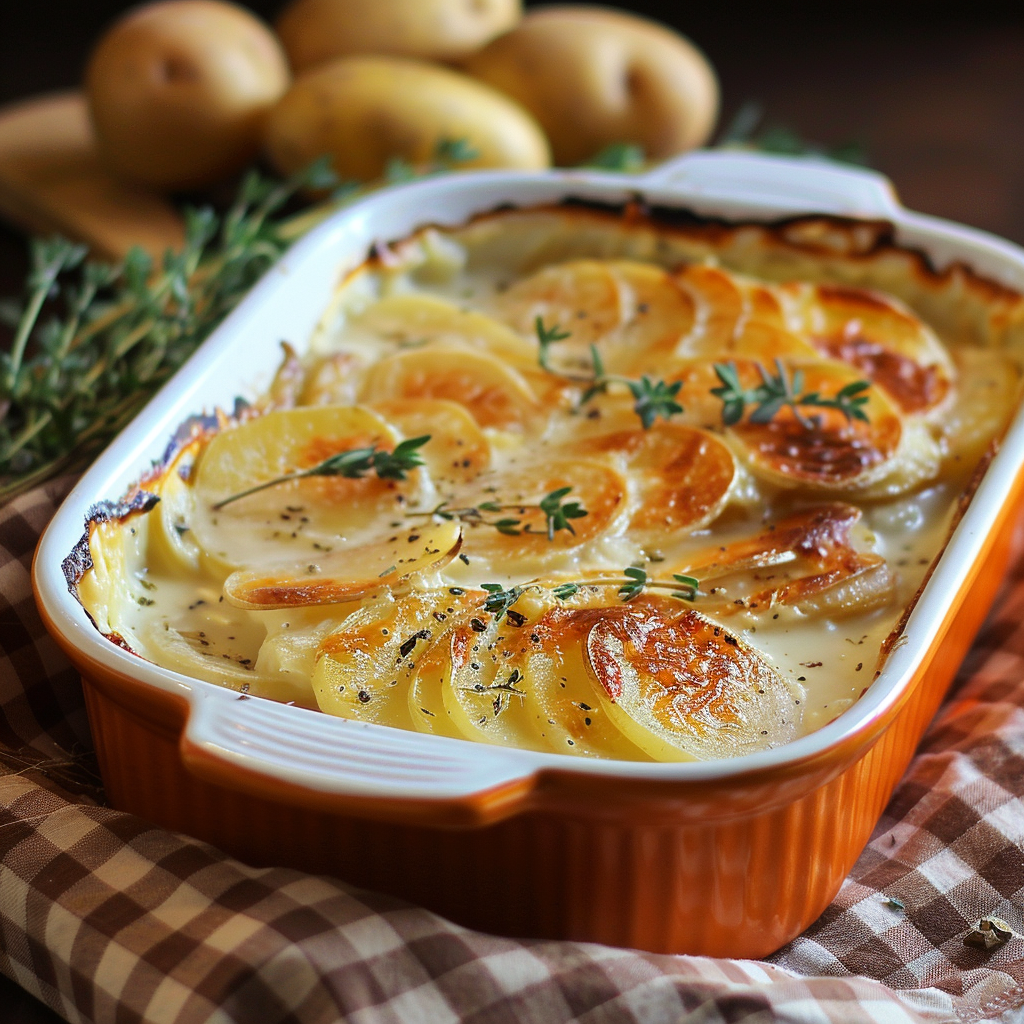Creamy Scalloped Potatoes – Perfect for Any Gathering

Share
Scalloped Potatoes Are A Classic Creamy Way To Prepare Potatoes
When family or friends gather for a cozy dinner, scalloped potatoes are the perfect dish to elevate simple ingredients like potatoes into something rich and creamy. This easy, yet impressive dish pairs well with roasted meats or a fresh green salad, and is always a hit on the table. Opting for a colorful baking dish adds a touch of presentation, while the creamy layers offer comfort and flavor that everyone will enjoy. Whether served at a special gathering or a casual dinner, this dish is sure to impress and satisfy.
Did You Know?
Scalloped potatoes originated in England and have been a staple in comfort food for centuries. The name "scalloped" is derived from the Old English word "collop," which referred to slices of meat or fish. Over time, this term was adapted to describe the thin slices of potato in this dish. Scalloped potatoes are often confused with au gratin potatoes, but traditionally, scalloped potatoes don’t include cheese, relying on the rich, creamy sauce for flavor.
Recipe:
Yield: 4 servings
Ingredients:
- 4 medium russet potatoes, thinly sliced
- 1 small onion, finely chopped
- 2 tablespoons butter
- 2 tablespoons all-purpose flour
- 2 cups milk
- 1 teaspoon salt
- 1/2 teaspoon ground black pepper
- 1/2 teaspoon dried thyme
Instructions:
-
Preheat Oven:
Preheat your oven to 375°F (190°C).
Personal Tip: Preheat your oven early to ensure it's ready by the time you're finished assembling the ingredients. -
Prepare White Sauce:
In a medium saucepan, melt the butter over medium heat. Add the flour and cook, stirring constantly, for 1-2 minutes until bubbly. Gradually whisk in the milk and cook until the mixture thickens and bubbles. Stir in the salt, pepper, and thyme until smooth.
Personal Tip: Stir continuously to avoid clumps in your sauce, and don’t rush the thickening process to achieve that perfect creamy consistency. -
Assemble Potatoes:
In a greased baking dish, layer half of the sliced potatoes and half of the chopped onion. Pour half of the white sauce over the potatoes. Repeat layers with the remaining potatoes, onion, and white sauce. If you have fresh thyme, you can put a bit on top.
Personal Tip: Layer the potatoes in a slight overlap to ensure even cooking and a better presentation. -
Bake:
Cover with foil and bake in the preheated oven for 30 minutes. Remove the foil and bake for an additional 25-30 minutes, or until the potatoes are tender and the top is golden brown.
Personal Tip: Removing the foil toward the end ensures the top layer gets golden and slightly crispy while the inside remains creamy. -
Serve:
Let the scalloped potatoes cool slightly before serving.
Personal Tip: Letting the dish sit for a few minutes allows the sauce to set, making it easier to serve and keeping the flavors balanced.
Nutritional Information (Per Serving):
Calories, 250 | Protein, 6g | Carbohydrates, 45g | Fiber, 4g | Net Carbohydrates, 41g | Fat, 8g | Saturated Fat, 5g | Cholesterol, 20mg | Sodium, 600mg | Sugars, 6g | Glycemic Index, Medium
Kitchen Tips, Great Ideas, How to Save Money
- Choosing Potatoes: Russet potatoes are ideal for scalloped potatoes due to their starchy texture, which helps thicken the sauce. Yukon Golds are a great alternative for a creamier texture.
- Slicing Potatoes: For even, thin slices, use a mandoline slicer. This ensures uniform cooking, preventing undercooked or overcooked pieces.
- Cheese Variation: Though traditional scalloped potatoes don't include cheese, you can sprinkle shredded cheddar or Gruyère between the layers and on top for a richer dish.
- Herb Enhancements: Fresh herbs like thyme, rosemary, or parsley can elevate the flavor. Use dried herbs sparingly as their flavor is more concentrated.
- Storing Leftovers: Store leftovers in an airtight container in the refrigerator for up to 3 days. Reheat in the oven or microwave until warmed through.
- Freezing Tips: Scalloped potatoes can be assembled and frozen before baking. Cover tightly with foil and freeze for up to 3 months. Thaw overnight before baking as directed.
- Serving Suggestions: Pair scalloped potatoes with roasted meats, poultry, or fish. A simple green salad or steamed vegetables also complement the dish.
- Reducing Fat: Use low-fat milk and reduce the butter for a lighter version. This can cut down on calories without sacrificing too much flavor.
- Flavor Enhancements: Adding a pinch of nutmeg to the white sauce provides a subtle depth of flavor. Alternatively, a splash of cream or half-and-half can make the sauce richer.
- Cost-Saving Tips: Buy potatoes in bulk when on sale. Using store-brand milk and butter helps reduce costs without compromising quality.
Let’s Learn About Different Varieties of Potatoes
Potatoes come in many varieties, each with its unique characteristics and best uses in cooking:
- Russet Potatoes: These are high in starch and have a fluffy texture, making them perfect for baking, frying, and mashing.
- Yukon Gold Potatoes: With a naturally buttery flavor and creamy texture, these potatoes are excellent for mashing and roasting.
- Red Potatoes: Known for their waxy texture, red potatoes hold their shape well, making them ideal for salads and roasting.
- Fingerling Potatoes: These small, elongated potatoes have a firm texture and rich flavor, great for roasting or grilling.
- Sweet Potatoes: With a naturally sweet flavor, sweet potatoes are ideal for baking, roasting, and using in casseroles.
Choosing the right variety of potato can make all the difference in your dish!


